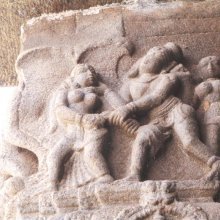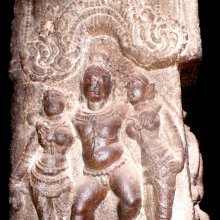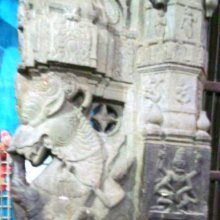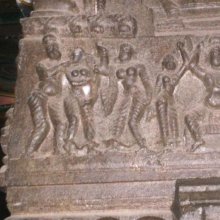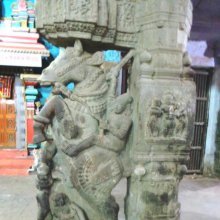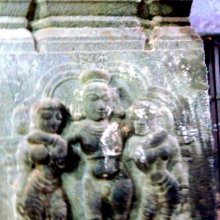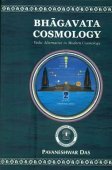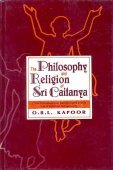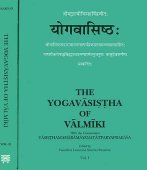Lila, Līlā, Līla, Līḷā: 34 definitions
Introduction:
Lila means something in Buddhism, Pali, Hinduism, Sanskrit, the history of ancient India, Marathi, Jainism, Prakrit, Hindi, biology. If you want to know the exact meaning, history, etymology or English translation of this term then check out the descriptions on this page. Add your comment or reference to a book if you want to contribute to this summary article.
The Sanskrit term Līḷā can be transliterated into English as Lila or Lilia, using the IAST transliteration scheme (?).
Images (photo gallery)
(+10 more images available)
In Hinduism
Vaishnavism (Vaishava dharma)
Source: ISKCON Press: GlossaryLīlā (लीला).—A transcendental “pastime” or activity performed by God or His devotee; The endlessly expanding spiritual activities and pastimes of Kṛṣṇa.
Source: Pure Bhakti: Bhagavad-gita (4th edition)Līlā (लीला) refers to “divine sportive pastimes of the Supreme Lord or His eternal associates”. (cf. Glossary page from Śrīmad-Bhagavad-Gītā).
Source: Pure Bhakti: Bhajana-rahasya - 2nd EditionLīlā (लीला) refers to:—The divine and astonishing pastimes of Śrī Bhagavān and His eternal associates. (cf. Glossary page from Bhajana-Rahasya).
Source: Pure Bhakti: Brhad BhagavatamrtamLīlā (लीला) refers to:—The Lord’s activities, or pastimes, of both cosmic creation and transcendental exchanges of love with His devotees. (cf. Glossary page from Śrī Bṛhad-bhāgavatāmṛta).

Vaishnava (वैष्णव, vaiṣṇava) or vaishnavism (vaiṣṇavism) represents a tradition of Hinduism worshipping Vishnu as the supreme Lord. Similar to the Shaktism and Shaivism traditions, Vaishnavism also developed as an individual movement, famous for its exposition of the dashavatara (‘ten avatars of Vishnu’).
Purana and Itihasa (epic history)
Source: archive.org: Shiva Purana - English Translation1) Līlā (लीला) refers to “divine sports”, according to the Śivapurāṇa 2.1.20.—“[...] thus lord Śiva who had assumed the form of Rudra performed divine sports (līlā) on the mount Kailāsa though he was foremost among Yogins. Thus lord Śiva spent some time without his divine consort. After some time He married Satī, the daughter of Dakṣa Prajāpati. Lord Śiva sported with her. Following the conventions of the world, O celestial sage, he became happy”.
2) Līlā (लीला) refers to “graceful charms”, according to the Śivapurāṇa 2.3.12.—Accordingly, after Himācala (i.e., Himālaya) brought his daughter (Pārvatī) before Śiva: “Then Śiva looked at her in the first flush of her youth. Her complexion resembled the full blown blue lotus petals. Her face appeared as the full moon. Her auspicious dress and features were the repositories of all graceful charms [i.e., samasta-līlā]. Her neck had the shape of the conch-shell. Her eyes were wide and her ears shone exquisitely. On either side, her long-rounded arms resembling a lotus-stalk shone beautifully. [...]”.
Source: Cologne Digital Sanskrit Dictionaries: The Purana IndexLīlā (लीला).—A Svara śakti.*
- * Brahmāṇḍa-purāṇa IV. 44. 57.

The Purana (पुराण, purāṇas) refers to Sanskrit literature preserving ancient India’s vast cultural history, including historical legends, religious ceremonies, various arts and sciences. The eighteen mahapuranas total over 400,000 shlokas (metrical couplets) and date to at least several centuries BCE.
Natyashastra (theatrics and dramaturgy)
Source: Wisdom Library: Nāṭya-śāstraLīlā (लीला, “sportive mimicry”) refers to one of the ten “natural graces” of women (svābhāvikā), according to the Nāṭyaśāstra chapter 24. These natural graces, also known as svabhāvaja or sahaja, represent one of the three aspects of graces (alaṃkāra) which forms which forms the support of sentiments (rasa) in drama. The natural graces (such as līlā) are defined according to the science of sāmānyābhinaya, or “harmonious representation”.
According to the Nāṭyaśāstra, “imitating the behaviour of a lover by means of relevant words, gestures and make-up (alaṃkāra, lit. ornament) which are delightful and inspired by affection, is called ‘sportive mimicry’ (līlā)”.

Natyashastra (नाट्यशास्त्र, nāṭyaśāstra) refers to both the ancient Indian tradition (shastra) of performing arts, (natya—theatrics, drama, dance, music), as well as the name of a Sanskrit work dealing with these subjects. It also teaches the rules for composing Dramatic plays (nataka), construction and performance of Theater, and Poetic works (kavya).
Kavya (poetry)
Source: Wisdom Library: KathāsaritsāgaraLīlā (लीला) or Līlāparvata is the name of a mountain whose lord is named Vikrośana: a Vidyādhara king who fought on Śrutaśarman’s side but was slain by Prabhāsa, who participated in the war against Sūryaprabha, according to the Kathāsaritsāgara, chapter 48. Accordingly: “... when they heard that [speech of Śrutaśarman], eight warriors in anger surrounded Prabhāsa.... And the third was the hero Indramālin, a prince of the Vidyādharas, lord of a host of distinguished warriors, and his home was the mountain Līlā”.
The Kathāsaritsāgara (‘ocean of streams of story’), mentioning Līlā, is a famous Sanskrit epic story revolving around prince Naravāhanadatta and his quest to become the emperor of the vidyādharas (celestial beings). The work is said to have been an adaptation of Guṇāḍhya’s Bṛhatkathā consisting of 100,000 verses, which in turn is part of a larger work containing 700,000 verses.

Kavya (काव्य, kavya) refers to Sanskrit poetry, a popular ancient Indian tradition of literature. There have been many Sanskrit poets over the ages, hailing from ancient India and beyond. This topic includes mahakavya, or ‘epic poetry’ and natya, or ‘dramatic poetry’.
Shaktism (Shakta philosophy)
Source: Google Books: ManthanabhairavatantramLīla (लील) refers to one of the eight Guardians (kṣetrapāla-aṣṭaka) associated with Nādapīṭha (identified with Kulūta), according to the Manthānabhairavatantra, a vast sprawling work that belongs to a corpus of Tantric texts concerned with the worship of the goddess Kubjikā.—[...] The eight Guardians (kṣetrapālāṣṭaka): Ekapāda, Budbuda, Ghaṇṭāvādanaka, Ghora, Gharghara, Valkala, Līla, Laṅkeśvara.
Source: Shodhganga: Saudarya Lahari of Sri Sankara A StudyLīlā (लीला) refers to one of the 54 rays of the Anāhata-Cakra which (together with the 62 rays of the Maṇipūra) are associated with the solar plane called Viṣṇugranthi, according to Śaṅkarācārya’s Saudaryalaharī.—Accordingly, the Goddess is visualised (by Sādhaka) as dwelling above the six Ādhāracakras ruling over the 360 rays which emanate in them [e.g., Līlā]. These 360 rays represent 360 syllables (i.e., a consummation of the śabdaprapañca or 50 alphabets) as well as the principles of nature. For the 360 syllables, together with haṃ and saḥ, Nyāsa should be performed for Śrīcakrapūjā.

Shakta (शाक्त, śākta) or Shaktism (śāktism) represents a tradition of Hinduism where the Goddess (Devi) is revered and worshipped. Shakta literature includes a range of scriptures, including various Agamas and Tantras, although its roots may be traced back to the Vedas.
Yoga (school of philosophy)
Source: Brill: Śaivism and the Tantric Traditions (yoga)Līlā (लीला) is a commentary on the Kāvyaprakāśa, authored by Bhavadeva-miśra, who also wrote the Yuktabhavadeva (a 17th-century text dealing with Yoga).—The NCC (vol. 4, 98) reports that it is by Bhavadeva, son of Kṛṣṇadeva of Mithila and pupil of Bhavadeva Ṭhakkura.

Yoga is originally considered a branch of Hindu philosophy (astika), but both ancient and modern Yoga combine the physical, mental and spiritual. Yoga teaches various physical techniques also known as āsanas (postures), used for various purposes (eg., meditation, contemplation, relaxation).
Shaiva philosophy
Source: archive.org: Chittanubodha Shastram By Bhaskara KanthaLīlā (लीला) refers to the “blissful play” of Śiva.—The Kashmir Śaiva thinkers believe in pluralism because not all human beings are alike and the different paths and Philosophies are meant for different kinds of people. The world is not rejected as unreal, but seen in the light of the reality of Śiva himself. The world is a manifestation of his blissful play (līlā). The central conception of the system is that the Supreme Reality, Śiva, is not only Consciousness (prakāśa, saṃvit, cit, etc.) but also Self-reflection (vimarśa).
-
Pancaratra (worship of Nārāyaṇa)
Source: archive.org: Catalogue of Pancaratra Agama TextsLīlā (लीला) refers to “God’s pleasure”, as discussed in chapter 1 of the (first part of the) Śāṇḍilyasaṃhitā: a Pāñcarātra text comprising 3600 Sanskrit verses dealing with devotion towards Kṛṣṇa who is identified with the Supreme, as well as ethical behavior and pious practices to be observed by devotees (bhaktas).—Description of the chapter [bhaktisvarūpa-ādi-līlāsṛṣṭi-ādi-prādurbhāva-varṇana]: [...] God has no reason for taking the initiative other than that it is the nature of His Graciousness to do so, or that it simply is His Pleasure [līlā] to do so. And the method He uses to awaken devotion to Him is to take human form on earth—using His śakti-power to transform Himself from a Divine Unity to His many Presences found in the three realms [līlā-sṛṣṭi / sṛṣṭakāryabhavā / chāyā-māyāmayī] (8-30a).

Pancaratra (पाञ्चरात्र, pāñcarātra) represents a tradition of Hinduism where Narayana is revered and worshipped. Closeley related to Vaishnavism, the Pancaratra literature includes various Agamas and tantras incorporating many Vaishnava philosophies.
Ayurveda (science of life)
Veterinary Medicine (The study and treatment of Animals)
Source: archive.org: The Elephant Lore of the HindusLīlā (लीला) refers to the “sport (of elephants)”, according to the 15th century Mātaṅgalīlā composed by Nīlakaṇṭha in 263 Sanskrit verses, dealing with elephantology in ancient India, focusing on the science of management and treatment of elephants.—[Cf. chapter 1 (“on the origin of elephants”)]:—“1. I revere the Man-lion (Viṣṇu) and the Yadavan (Kṛṣṇa), two shining (also, punningly, ruling) forest fires for the dread jungle of hosts of devils, the two gods who wear the formal pomp of kings of kings. 2. Having made obeisance to the Elephant-faced, having studied the Science of Elephants expounded by the distinguished Sage (Pālakāpya), having let my mind dwell upon the sport of elephants (mātaṅga-līlā), I now compose this ‘Elephant-Sport’. [...]”.

Āyurveda (आयुर्वेद, ayurveda) is a branch of Indian science dealing with medicine, herbalism, taxology, anatomy, surgery, alchemy and related topics. Traditional practice of Āyurveda in ancient India dates back to at least the first millenium BC. Literature is commonly written in Sanskrit using various poetic metres.
General definition (in Hinduism)
Source: WikiPedia: HinduismLila (Sanskrit: लीला, līlā) is a concept within Hinduism literally meaning "pastime", "sport" or "play". It is common to both non-dualistic and dualistic philosophical schools, but has a markedly different significance in each. Within non-dualism, Lila is a way of describing all reality, including the cosmos, as the outcome of creative play by the divine absolute (Brahman). In the dualistic schools of Vaishnavism, Lila more simply refers to the activities of God and his devotees, as distinct from the common activities of karma.
In Buddhism
Mahayana (major branch of Buddhism)
Source: Wisdom Library: Maha Prajnaparamita SastraLīlā (लीला) refers to “play”, representing one of the various actions of Māra, according to Mahāprajñāpāramitāśāstra (chapter 10).—Accordingly, “[Question: What are the works of Māra?]—[Answer].—[...] Māra has three types of actions: (a) play (līlā), laughter, idle chatter, singing, dancing, and everything that provokes desire; (b) iron fetters, beating, whipping, wounds, spikes, knives, slashing and everything that is caused by hatred; (c) [demented mortifications] such as being burned, being frozen, tearing out one’s hair, starving, jumping into the fire, throwing oneself into the water, falling onto spears and everything that results from stupidity”.

Mahayana (महायान, mahāyāna) is a major branch of Buddhism focusing on the path of a Bodhisattva (spiritual aspirants/ enlightened beings). Extant literature is vast and primarely composed in the Sanskrit language. There are many sūtras of which some of the earliest are the various Prajñāpāramitā sūtras.
India history and geography
Source: Wisdom Library: Teachers, Saints and SagesLilā (लिला) or Lilāpā is another name for Lollapā: one of the eighty-four Siddhas (Siddhācāryas) of the Sahajayāna school, according to sources such as the Varṇaratnākara of Jyotirīśvara (i.e., the Varna-Ratnakara by Jyotirishwar Thakur).—The Sahaja-Yana is a philosophical and esoteric movement of Tantric Buddhism which had enormous influence in the Indian subcontinent and the Himalayas.—Many of these Mahāsiddhas [e.g., Lilā-pā] were historical figures whose lives and mystical powers were the subject of legends. They are often associated with teachings belonging to Hinduism, Buddhism, Ajivikism and Jainism such as the Nath Tradition.

The history of India traces the identification of countries, villages, towns and other regions of India, as well as mythology, zoology, royal dynasties, rulers, tribes, local festivities and traditions and regional languages. Ancient India enjoyed religious freedom and encourages the path of Dharma, a concept common to Buddhism, Hinduism, and Jainism.
Biology (plants and animals)
Source: Google Books: CRC World Dictionary (Regional names)1) Lila in Mexico is the name of a plant defined with Clidemia hirta in various botanical sources. This page contains potential references in Ayurveda, modern medicine, and other folk traditions or local practices It has the synonym Staphidium elegans (Aubl.) Naudin (among others).
2) Lila is also identified with Melia azedarach It has the synonym Azedaraca amena Raf. (etc.).
Example references for further research on medicinal uses or toxicity (see latin names for full list):
· A General History of the Dichlamydeous Plants (1831)
· Biodiversidad del estado de Tabasco (2005)
· Revisio Generum Plantarum (1891)
· Flora de Filipinas (1837)
· FBI (1875)
· Phytotherapy Research (2003)
If you are looking for specific details regarding Lila, for example side effects, extract dosage, chemical composition, pregnancy safety, diet and recipes, health benefits, have a look at these references.

This sections includes definitions from the five kingdoms of living things: Animals, Plants, Fungi, Protists and Monera. It will include both the official binomial nomenclature (scientific names usually in Latin) as well as regional spellings and variants.
Languages of India and abroad
Pali-English dictionary
Source: BuddhaSasana: Concise Pali-English Dictionarylīlā : (f.) grace; charm.
Source: Sutta: The Pali Text Society's Pali-English DictionaryLīlā, (līḷā) (f.) (cp. Epic Sk. līlā or *līḍā) play, sport, dalliance; probably for līḷhā at J. V, 5 & 157, both times combined with vilāsa.

Pali is the language of the Tipiṭaka, which is the sacred canon of Theravāda Buddhism and contains much of the Buddha’s speech. Closeley related to Sanskrit, both languages are used interchangeably between religions.
Marathi-English dictionary
Source: DDSA: The Molesworth Marathi and English Dictionaryliḷā (लिळा).—f (līlā S) Sport, diversion, pastime,play. liḷā phiraṇēṃ -badalaṇēṃ -pālaṭaṇēṃ g. of s. To change one's course from good to bad or vice versâ.
--- OR ---
līlā (लीला).—f (S) Sport, diversion, pastime or play in general. 2 (Abridged from līlāvatāra q.v. infra.) An incarnation of Viṣṇu. Hence līlā- dhāraṇa Assumption of an incarnation, and līlā- dhārī Assumer of &c.
--- OR ---
līlā (लीला) [or लीळा, līḷā].—ad (Poetry.) As it were in play; easily. See avalīḷā.
Source: DDSA: The Aryabhusan school dictionary, Marathi-Englishlīlā (लीला).—f Play or pastime, sport.
--- OR ---
liḷā (लिळा).—f Play or pastime, sport.
Marathi is an Indo-European language having over 70 million native speakers people in (predominantly) Maharashtra India. Marathi, like many other Indo-Aryan languages, evolved from early forms of Prakrit, which itself is a subset of Sanskrit, one of the most ancient languages of the world.
Sanskrit dictionary
Source: DDSA: The practical Sanskrit-English dictionaryLīlā (लीला).—[lī-kvip liyaṃ lāti lā-ka vā Tv.]
1) Play, sport, pastime, diversion, pleasure, amusement; क्लमं ययौ कन्दुक- लीलयापि या (klamaṃ yayau kanduka- līlayāpi yā) Kumārasambhava 5.19; oft. used as the first member of comp.; लीलाकमलम्, लीलाशुकः (līlākamalam, līlāśukaḥ) &c.
2) Amorous pastime, wanton, amorous or playful sport; उत्सृष्टलीलागतिः (utsṛṣṭalīlāgatiḥ) R.7. 7;4.22;5.7; क्षुभ्यन्ति प्रसभमहो विनापि हेतोर्लीलाभिः किमु सति कारणे रमण्यः (kṣubhyanti prasabhamaho vināpi hetorlīlābhiḥ kimu sati kāraṇe ramaṇyaḥ) Śiśupālavadha 8.24; Meghadūta 37; (līlā in this sense is thus explained by ujjavalamaṇi:aprāptavallabhasamāgamanāyikāyāḥ sakhyāḥ puro'tra nijacittavinodabuddhyā | ālāpaveśagatihāsyavilokanādyaiḥ prāṇeśvarānukṛtimāphalayanti līlām ||).
3) Ease, facility, mere sport, child's play; लीलया जघान (līlayā jaghāna) 'killed with ease'.
4) Appearance, semblance, air, mien; यः संयति प्राप्तपिनाकि- लीलः (yaḥ saṃyati prāptapināki- līlaḥ) R.6.72 'appearing like Pinākin'.
5) Beauty, charm, grace; मुहुरवलोकितमण्डनलीला (muhuravalokitamaṇḍanalīlā) Gītagovinda 6; R.6.1;16 71.
6) Pretence, disguise, dissimulation, sham; as, लीलामनुष्यः, लीलानटः (līlāmanuṣyaḥ, līlānaṭaḥ) &c.
7) Frivolity, disrespect; दातव्य- मन्नं विधिवत् सत्कृत्य न तु लीलया (dātavya- mannaṃ vidhivat satkṛtya na tu līlayā) Rām.1.13.14.
8) Action.
Source: Cologne Digital Sanskrit Dictionaries: Shabda-Sagara Sanskrit-English DictionaryLīlā (लीला).—f.
(-lā) 1. A branch of feminine action, proceeding from love; or the imitation of a lover’s manner, speech, gait, &c. by his mistress, to pass the time in his absence. 2. Play, sport, pastime in general. 3. Amorous or wanton sport. 4. Fecility in doing anything. 5. Mien, manner. 6. Grace, charm. 7. Pretence, disguise, sham. 8. A species of the Dandaka metre. E. lī to embrace, kvip aff., and lā to get or give, affs. ka and ṭāp .
Source: Cologne Digital Sanskrit Dictionaries: Benfey Sanskrit-English DictionaryLīlā (लीला).— (akin to las), f. 1. Play, sport, pastime, [Pañcatantra] 161, 15; līlayā (instr.), Sportively, [Pañcatantra] 229, 10; easily, without any effort, [Pañcatantra] 211, 12; [Hitopadeśa] 81, 18. 2. Amorous or wanton sport, [Pañcatantra] iii. [distich] 237.
Source: Cologne Digital Sanskrit Dictionaries: Cappeller Sanskrit-English DictionaryLīlā (लीला).—[feminine] play, sport, amusement, pastime; wantonness, grace, beauty, charm; mere play or sport, i.e. either ease or facility in doing anything; or appearance, semblance, pretence. °— & [instrumental] for sport, without effort; feignedly.
Source: Cologne Digital Sanskrit Dictionaries: Monier-Williams Sanskrit-English Dictionary1) Līlā (लीला):—f. (derivation doubtful) play, sport, diversion, amusement, pastime, [Mahābhārata; Kāvya literature] etc.
2) mere sport or play, child’s play, ease or facility in doing anything, [ib.]
3) mere appearance, semblance, pretence, disguise, sham, [Kāvya literature; Kathāsaritsāgara; Purāṇa] ([in the beginning of a compound] sportively, easily, in sport, as a mere joke ; also = līlayā ind. for mere diversion, feignedly)
4) grace, charm, beauty, elegance, loveliness, [Kālidāsa; Kathāsaritsāgara; Rājataraṅgiṇī]
5) (in [rhetoric]) a maiden’s playful imitation of her lover, [Daśarūpa; Sāhitya-darpaṇa; Pratāparudrīya]
6) a kind of metre (4 times ¯ ˘ ˘ ¯ ˘ ˘ ¯ ˘ ˘ ¯ ˘ ˘ ¯ ˘ ˘ ¯), [Colebrooke]
7) Name of a Yoginī, [Hemacandra’s Pariśiṣṭaparvan]
Source: Cologne Digital Sanskrit Dictionaries: Yates Sanskrit-English DictionaryLīlā (लीला):—(lā) 1. f. A branch of feminine action proceeding from love; play, sport, dalliance.
Source: DDSA: Paia-sadda-mahannavo; a comprehensive Prakrit Hindi dictionary (S)Līlā (लीला) in the Sanskrit language is related to the Prakrit word: Līlāya.
[Sanskrit to German]
Sanskrit, also spelled संस्कृतम् (saṃskṛtam), is an ancient language of India commonly seen as the grandmother of the Indo-European language family (even English!). Closely allied with Prakrit and Pali, Sanskrit is more exhaustive in both grammar and terms and has the most extensive collection of literature in the world, greatly surpassing its sister-languages Greek and Latin.
Hindi dictionary
Source: DDSA: A practical Hindi-English dictionaryLīlā (लीला) [Also spelled lala]:—(nf) sport, play; amorous sport; fun and frolic; stage representation [of the deeds of divine incarnations, e.g, [rāmalīlā, rāsa-līlā]; -kalaha] love strife; ~[priya] frolicsome; ~[puruṣa] an epithet of Lord Krishna who revelled in his divine sport; ~[maya] sportive; playful; ~[sthala] site of amorous sport/play.
...
Prakrit-English dictionary
Source: DDSA: Paia-sadda-mahannavo; a comprehensive Prakrit Hindi dictionaryLīlā (लीला) in the Prakrit language is related to the Sanskrit word: Lolā.
Prakrit is an ancient language closely associated with both Pali and Sanskrit. Jain literature is often composed in this language or sub-dialects, such as the Agamas and their commentaries which are written in Ardhamagadhi and Maharashtri Prakrit. The earliest extant texts can be dated to as early as the 4th century BCE although core portions might be older.
Nepali dictionary
Source: unoes: Nepali-English DictionaryLīlā (लीला):—n. 1. sport; game; entertainment; play; drama; playacting; 2. luxury; indulgence; amorous play; wantonness; 3. spontaneous; effortless; action; 4. disguise; pretext;
Nepali is the primary language of the Nepalese people counting almost 20 million native speakers. The country of Nepal is situated in the Himalaya mountain range to the north of India.
See also (Relevant definitions)
Partial matches: De, A, Alia, Lila, Te.
Starts with (+22): Lilabharana, Lilabja, Lilacandra, Lilacatura, Liladagdha, Liladevi, Lilagati, Lilageha, Lilagriha, Lilakalaha, Lilakamala, Lilakara, Lilakhela, Lilamadhurya, Lilamandira, Lilamanushya, Lilamatra, Lilamatrena, Lilamaya, Lilambuja.
Query error!
Full-text (+351): Salila, Lilavati, Lilavatara, Avalila, Lilodyana, Balalila, Simhalila, Lilabja, Lilaravinda, Lilashuka, Lilavapi, Lilakhela, Lilapadma, Lilakalaha, Lilabharana, Lilakara, Lilanga, Lilakamala, Lilavajra, Lilanritya.
Relevant text
Search found 133 books and stories containing Lila, Aḷa-a, Aḷa-a, Alia-a, Alia-a, De lila, Līlā, Liḷā, Līla, Lilā, Līḷā, Lila's, Lilan, Lilas; (plurals include: Lilas, as, De lilas, Līlās, Liḷās, Līlas, Lilās, Līḷās, Lila'ses, Lilans, Lilases). You can also click to the full overview containing English textual excerpts. Below are direct links for the most relevant articles:
Garga Samhita (English) (by Danavir Goswami)
Verse 2.2.38 < [Chapter 2 - Description of Girirāja Govardhana’s Birth]
Verse 1.2.48 < [Chapter 2 - Description of the Abode of Śrī Goloka]
Verse 2.25.33 < [Chapter 25 - The Rāsa-dance Pastime]
Brihad Bhagavatamrita (commentary) (by Śrī Śrīmad Bhaktivedānta Nārāyana Gosvāmī Mahārāja)
Verse 1.4.98 < [Chapter 4 - Bhakta (the devotee)]
Verse 2.4.257 < [Chapter 4 - Vaikuṇṭha (the spiritual world)]
Verse 2.4.268 < [Chapter 4 - Vaikuṇṭha (the spiritual world)]
Sahitya-kaumudi by Baladeva Vidyabhushana (by Gaurapada Dāsa)
Text 10.193 < [Chapter 10 - Ornaments of Meaning]
Text 7.154 < [Chapter 7 - Literary Faults]
Text 9.28 < [Chapter 9 - Ornaments of Sound]
Bhakti-rasamrta-sindhu (by Śrīla Rūpa Gosvāmī)
Verse 2.1.343 < [Part 1 - Ecstatic Excitants (vibhāva)]
Verse 2.1.209 < [Part 1 - Ecstatic Excitants (vibhāva)]
Verse 4.8.73 < [Part 8 - Compatible & Incompatible Mellows (maitrī-vaira-sthiti)]
A Brief Survey of the Puranas on the Krishna Lila < [Purana, Volume 11, Part 1 (1969)]
Book-review (grantha-samalocana) < [Purana, Volume 6, Part 1 (1964)]
Amplification of the Vedas by the Dharmasastra, Itihasa and Puranas < [Purana, Volume 4, Part 1 (1962)]
Related products
